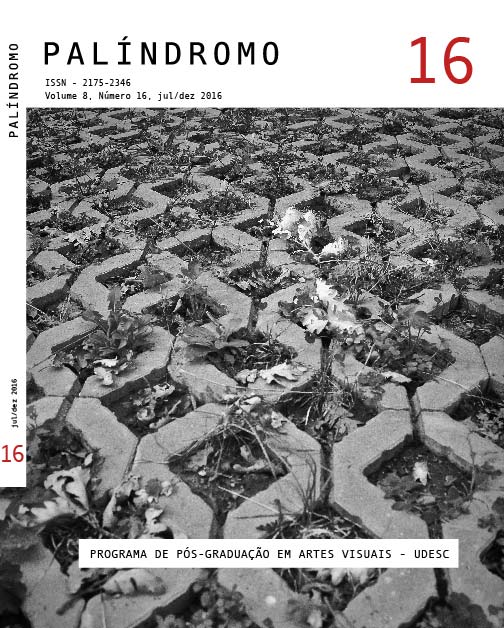The Augustus’ (Statue) Portraits Types
DOI:
https://doi.org/10.5965/2175234607132015065Keywords:
portrait , Augustus , roman art , art and contextAbstract
This work approches the portrait at Augustan Era, the most important be- tween all roman emperors, in addition to having more time at the government. When assumed the control, Augustus had chance to start something new, taking a pictorial language consciously designed to ensure your government and as a way to change the preconceived ideas of the population. That said, the entire produc- tion of art was a testament to the power and authority of the emperor.
The portraits type are approached based on Dietrich Boschung’s (1993) work. For this, this work starts from the relevance of this three-dimensional kind of representation had within the Roman society, both for the senatorial class and for the plebs, reaching the imperial repre- sentation of Augustus. Facing the nume- rous approaches currently practiced in studies on the History of Ancient Roman Art, we opted for that called “art and con- text,” which puts its focus on production, operation and reception of artistic works. To this end, authors like Peter Stewart (2008) are used to discuss how the art objects were produced, how worked and how they were received, with the main concern on the study of a Social History of Roman Art; and Paul Zanker (1988 and 2012), which considers that the visual arts are mainly a way to dialogue outlined the values and realities of society. Howe- ver, the formal and aesthetic issues have not become obsolete, the fact is that the answers to them are focusing on the his- torical context and adapted forms for images’ messages (Zanker, 2012). Thus, the art is now considered as an element of the communication and not as some- thing independent.
Downloads
References
ARGAN, Giulio C. História da arte italiana – 1. Da Antiguidade a Duccio. São Paulo: Cosac Naify, 2003.
BONANNO, Anthony. Sculpture. In: HENIG, Martin (ed.). A Handbook of Roman Art –
A survey of the Visual Arts of the Roman World. London: Phaidon Press, 1994.
. Imperial and Private Portraiture: a case of non-dependence. In: BONACASA, Nicola e RIZZA, Giovanni (org.). Ritratto ufficiale e Ritratto Privato – Atti dela II Conferenza Internazionale sul Ritratto Romano. Roma: Consiglio Naziona- le dele Ricerche, 1998, p. 157.
BOSCHUNG, Dietrich. Die Bildnisse des Augustus. Berlim: Gebr. Mann Verlag, 1993.
BRILLIANT. Richard. Roman Art – from the Republic to Constantine. London: Phai- don, 1974.
BURNETT, Andrew. The Image of Augustus. London: British Museum Publications, 1981.
FEJFER, Jane. Roman Portraits in Context. Berlin: Walter de Gruyter, 2008.
FREL, Jiří K. Roman Portraits in the Getty Museum. Tulsa: Philbrook Art Center, 1981.
HALLETT, Christopher H. The Roman Nude: Heroic Portrait Statuary 200 BC-AD 300. Oxford: Oxford University Press, 2005.
HÖLSCHER, Tonio. L’Archeologia Classica: Un’Introduzione. Roma: L’Erma di Brets- chneider, 2010.
KLEINER, Diana E. E. Roman Sculpture. Yale: Yale University Press, 1992.
KLEINER, Fred S. A History of Roman Art. Boston: Wadsworth Cengage Learning, 2010.
KOUSSER, Rachel. Adapting Greek Art. In: BORG, Barbara E. (ed.). A Companion to Roman Art. Oxford: Wiley Blackwell, 2015.
MARTINS, Paulo. Imagem e Poder. Considerações sobre a representação de Otávio Augusto. São Paulo: Edusp, 2011.
MAYER, Emanuel. Propaganda, staged appaluse, or local politics? – Public Monu- ments from Augustus to Septimus Severus. IN: EWALD, Björn C. e NOREÑA, Carlos F. (ed.). The Emperor and Rome – Space, Representation, and Ritual. Nova York: Cam- bridge University Press, p. 111-134, 2010.
POLLINI, John. Die Bildnisse des Augustus by Dietrich Boschung. The Art Bulletin, Vol. 81, No. 4, p. 723-735, 1999.
. Ritualizing death in Republican Rome: memory, religion, class stru- ggle, and the wax ancestral mask tradition’s origin and influence on veristic portraitu- re. In: LANERI, Nicola (ed.). Performing Death – Social analyses of funerary traditions in the ancient near east and mediterranean. Chicago: The Oriental Institute, 2008.
. From the republic to empire: rhetoric, religion, and power in the visual culture of ancient Rome. Norman: University of Oklahoma Press, 2012.
SCHOLLMEYER, Patrick. La scultura romana: Un’introduzione. Roma: Apeiron, 2007.
SMITH, Roland R. R. Typology and diversity in the portraits of Augustus. Journal of Roman Archeology, Vol. 9, p. 31-47, 1996.
SQUIRE, Michael. Embodied Ambiguities on the Prima Porta Augustus. Art History, Vol. 36, p. 242–279, 2013.
WALKER, Susan. The Image of Augustus. London: British Museum Publications, 1981.
. Greek and Roman Portraits. London: British Museum, 1995. WEST, Shearer. Portraiture. Oxford: Oxford University Press, 2004.
WOOD, Susan. Portraiture. In: FRIEDLAND, Elise A., GAZDA, Elaine K. e SOBOCINSKI, Melanie Grunow (ed.). The Oxford Handbook of Roman Sculpture. Nova York: Oxford University Press, p. 260-275, 2015.
ZANKER, Paul. The Power of Images in the Age of Augustus. Michigan: The University of Michigan Press, 1988.
. Arte Romana. Roma: Editori Laterza, 2012.
Downloads
Published
How to Cite
Issue
Section
License
Copyright (c) 2016 Mayara Amaral Fernandes

This work is licensed under a Creative Commons Attribution 4.0 International License.
COPYRIGHT STATEMENT
The articles published by the magazine are free to use, intended for academic and non-commercial applications. Copyright is all assigned to the magazine. The articles whose authors are identified represent the expression from the point of view of their authors and not the official position of Palíndromo Magazine. The author (s) commits to whenever they publish material referring to the article published in Palíndromo mention this publication as follows:
This article was originally published by Palíndromo magazine in its volume (place the volume), number (place the number) in the year of (place the year) and can be accessed at: http://www.revistas.udesc.br/index.php/palindromo


